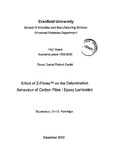JavaScript is disabled for your browser. Some features of this site may not work without it.
| dc.contributor.advisor | Partridge, Ivana K. | |
| dc.contributor.author | Cartié, Denis D. R. | |
| dc.date.accessioned | 2009-03-20T11:33:42Z | |
| dc.date.available | 2009-03-20T11:33:42Z | |
| dc.date.issued | 2000-12 | |
| dc.identifier.uri | http://hdl.handle.net/1826/3293 | |
| dc.description.abstract | The study presented in this thesis investigates the relationship between the experimentally determined behaviour of Z-pinned laminates under various delamination fracture loading conditions and their mesostructure Mode I, mode II and mixed mode 1/11 delamination fracture testing was carned out on Z-Fibre reinforced unidirectional beams of IMS/924 laminates For the Double Cantilever Beam specimens (DCB) under mode I loading, the crack propagation resistance of the beam is enhanced with increased pinning density For the range of pin diameters and pmmng densities used for this study, the load carrying capability has been improved by up to 5 times and the apparent toughness has been improved by up to 20 times The most noteworthy example of the effectiveness of ZFibreTM pinning is the stabilisation of delamination crack propagation under mode II loading conditions in the intrinsically unstable 3pt-ENF configuration Although the current data analyses, based on LEFM, included in the test protocols for the calculation of delamination toughness values are invalidated by the presence of the through-the- thickness reinforcement, they are used here as the best currently available means of normalising the fracture results However, these data reduction methods do not allow direct quantification of effects of the different pinning parameters on the crack bridging capability of the through-the- thickness reinforcement In order to relate the micromechanics at the pin level with the Mesomechanics of the delamination fracture specimens, the determination of the traction laws of a single Z-Fibre, bridging a crack and deformmg under various loading conditions, have been determined successfully by single pin experiments A finite element approach, utilising these experimentally determined single pin bridging laws, is presented as a tool to cany out parametric studies of the effects of pin length, diameter and location on the behaviour of delaminating beams The good agreement between the simulated and experimental R-curves demonstrates that the mode I delamination behaviour of DCB specimens is related to the single pin pullout traction laws Finally, preliminary studies of the compression after impact behaviour of ZFibreTh reinforced laminates indicate the existence of a complex relationship between the dramatic enhancement of the delamination crack propagation resistance of a material and the much lower (up to 50%) ultimate improvement in its compression after impact performance | en_UK |
| dc.language.iso | en | en_UK |
| dc.publisher | Cranfield University | en_UK |
| dc.title | Effect of Z-fibres(TM) on the delamination behaviour of carbon-fibre/epoxy laminates | en_UK |
| dc.type | Thesis or dissertation | en_UK |
| dc.type.qualificationlevel | Doctoral | en_UK |
| dc.type.qualificationname | PhD | en_UK |
